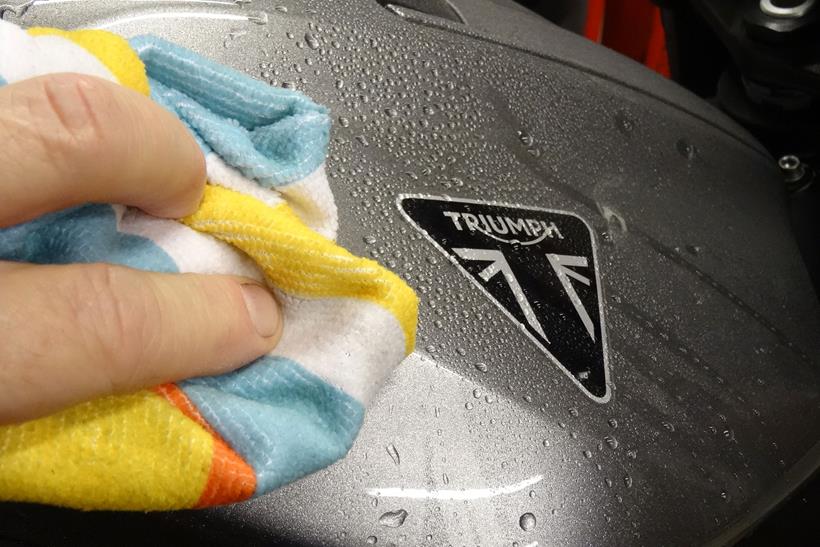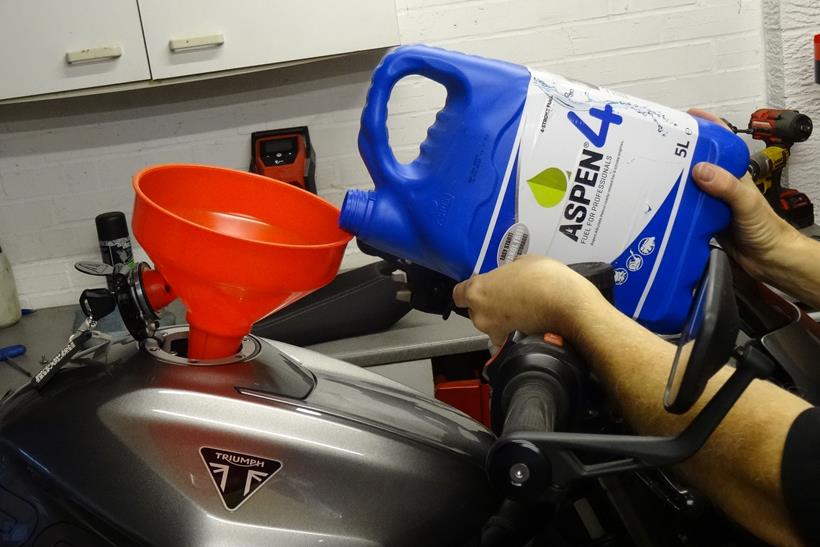Here's your guide to preparing your bike for winter storage so it's good to go in spring

Plenty of bikers in the UK prefer not to ride through the winter months – whether that’s because they don’t want to expose their pride and joy to road salt, they ride focused sportsbikes that wouldn’t be much fun in the conditions, or simply because they don’t like it.
Whatever your reason for hibernating a motorcycle, there are a few steps you should take to ensure the job of putting your bike back on the road is as easy as possible. Some of them will also help to avoid hefty bills for replacement parts or even damaged engines in extreme cases.
There’s loads of advice out there on the internet and it can range from great to potentially dangerous, but Bruce Dunn is an advanced motorbike mechanic with decades in the trade. Here is his list of advice for storing a bike over winter.

Ultra clean and dry
Wash the bike all over with a dedicated motorcycle cleaner and use a brush to get behind exhaust downpipes and into awkward places. You’re aiming to get the bike as clean as possible, so be diligent. You also need to make sure it’s thoroughly dried; an airline or bike dryer is ideal for blasting away water. If not, rub it all over with a soft towel or cloth.


Choose your spot, then lift
Work out where you’re going to put your bike while it’s in storage – it should be in a dry area and not where someone is going to trip over it. Next, place the bike on front and rear stands to reduce the risk of damage to the tyres. If you don’t have paddock stands, simply slide mats under both wheels to insulate the tyres from the cold garage floor.


Give it a protective coating
It’s a good idea to cover your bike in an anti-corrosion spray while it’s in storage. Rather than spray it wildly over the bike, apply the treatment to an absorbent cloth then wipe it evenly over the surfaces. Use it on metal surfaces, exposed spindle ends, bolts and chain adjusters. The treatment can be applied to plastics in the same way.


Get yourself connected
Locate your bike’s battery and connect it to a conditioner/charger – this will keep the battery at its peak condition all of the time and will ward off parasitical drain from an alarm and/or tracker. If your battery is of the old lead-acid variety, check the fluid levels and (if necessary) top-up with distilled water before connecting the charger.
Simply plug it in and let it take care of your battery - it couldn't be much easier.
Pros
Cons
Don’t forget the chain
Make sure the chain is clean and dry. Treat it as an individual component with its own cleaning routine, using dedicated chain cleaning products. If it needs adjusting, this is a good time to do it. Lubricate carefully, take your time and don’t miss any links.


Up the pressure
When going into storage, it’s important to pump the tyres up harder than the stock pressures to ensure they don’t deflate over time and damage the carcass – especially if you don’t have paddock stands. Go up 20psi over the stock and recheck every two months.


Don’t risk the ethanol
Storing a bike with fuel in will help keep seals in good health – as long as it’s ethanol-free or a type that won’t degrade, such as Aspen 4. Drain the tank and run the bike out of fuel, then fill with Aspen 4. This 5-litre can costs £30 and we will just use a couple of litres.
Lock it, don’t lose it
It’s prudent to add another level of security. The last thing you want is to come back in the Spring and discover your bike missing. Install a ground anchor and then chain your bike to it using a meaty lock. Or failing that, put an extra lock on the garage door.


- Sold Secure Motorcycle Diamond rating
- Versatile mounting options


Find the lock here
Pros
Cons
Get mouse-proof!
Rodents have been known to make their nests inside a stored bike’s airbox, munching away and causing damage. Setting a mousetrap is one way to deal with the problem, or for a more humane solution – block off all your bike’s nooks and crannies.
Tuck it in and say goodnight
Pull a dedicated bike cover over your machine. These are shaped correctly and if the right size is selected it should cover the bike perfectly. And don’t hide the battery charger under the cover – they usually have displays that indicate the status of the battery.
What’s the problem with ethanol?
One of the questions I get asked most often is about what to do with fuel when storing a bike. Storing a bike dry should be avoided, as it can cause residue left in the fuel system to gum up, creating problems further down the line.
You really want to be storing a bike with fuel that’s free from ethanol, and previously I recommended Esso’s Synergy Supreme 99+ as it was ethanol free. Shame, though, because as of September this is no longer the case and this super unleaded now has up to 5% ethanol.
This is where a dedicated storage fuel such as Aspen 4 or VP 4-Cycle Fuel is a good idea, as it’s stable for up to five years, won’t degrade and contains no damaging ethanol. It also allows you to start the bike every now and then to keep things ticking over. There’s even a dedicated pre-mixed version for two-strokes.

Be warned, it’s worth noting that on older machines which might’ve already suffered damage to rubber components, storage fuel may cause leaks when the fuel causes the already perished rubber parts to revert back to shape, crack and fail.



